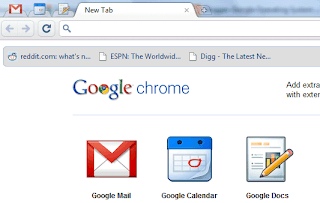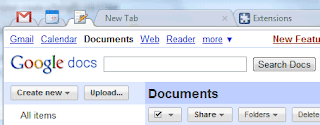If you use the Google Chrome Dev Channel or a recent Chromium build, you can install 3 Google apps: Gmail, Google Calendar and the Google Docs.
"An installed web app could be separated visually from the other tabs, could integrate better with the OS, and could be granted increased with permissions. Installing a web app in Google Chrome is easy and quick, with no restart required. At its simplest, installing a web app is like creating a super-bookmark to it," then explains Google.
"An installed web app could be separated visually from the other tabs, could integrate better with the OS, and could be granted increased with permissions. Installing a web app in Google Chrome is easy and quick, with no restart required. At its simplest, installing a web app is like creating a super-bookmark to it," then explains Google.

To install a web app, you need to write a small Chrome of extension that includes one or more icons, the URLs used by the applications and the permissions that are required.
Chrome already includes extensions for 3 popular Google services and here's how to add them:
Chrome already includes extensions for 3 popular Google services and here's how to add them:
1. Make sure you use the Chrome Dev Channel 6 or a recent Chromium build.
2. Edit Chrome's desktop shortcut and add a command-line in flag. In Windows, right-click on the shortcut, then select "Properties", append a space followed by --enable-apps in the Target field and restart Chrome.
3. Open Chrome, go to chrome://extensions and click on "Developer mode".
4. Click on the "load unpacked extension" and navigate to Chrome's resources folder. Here's the location of the folder in the Windows:
%USERPROFILE%\AppData\Local\Google\Chrome\Application\[Version]\resources (Vista, Windows 7)
%USERPROFILE%\Local Settings\Application Data\Google\Chrome\Application\[Version] \resources (Windows XP)
5. Click on one of the three folders: gmail_app, calendar_app, docs_app and repeat the steps 4-5 for the other two of folders.
6. To add the applications to the tabstrip, you need to click on the icons from the new tab of page.
2. Edit Chrome's desktop shortcut and add a command-line in flag. In Windows, right-click on the shortcut, then select "Properties", append a space followed by --enable-apps in the Target field and restart Chrome.
3. Open Chrome, go to chrome://extensions and click on "Developer mode".
4. Click on the "load unpacked extension" and navigate to Chrome's resources folder. Here's the location of the folder in the Windows:
%USERPROFILE%\AppData\Local\Google\Chrome\Application\[Version]\resources (Vista, Windows 7)
%USERPROFILE%\Local Settings\Application Data\Google\Chrome\Application\[Version] \resources (Windows XP)
5. Click on one of the three folders: gmail_app, calendar_app, docs_app and repeat the steps 4-5 for the other two of folders.
6. To add the applications to the tabstrip, you need to click on the icons from the new tab of page.

Web apps are added to the new tab page, they use special pinned tabs that no longer include the Omnibox and the Gmail app has an option for the desktop notifications, which doesn't seem to be enabled.
"Once installed, a web app gets a big icon in the Google Chrome's app launcher area, as well as some integration with the host OS. When running, an installed web app has a special frame and other UI enhancements to make the web app easier to the distinguish from other web content. This special treatment makes running apps easier to find and then prevents accidentally opening multiple copies of them."
Google will launch a Chrome Web Store for web apps, where you'll be able to find an install the other applications. Until then, you can create extensions for your favorite web apps.

No comments:
Post a Comment